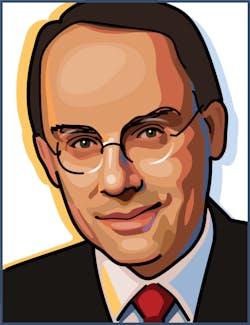
(Image. WLT president Andreas Ostendorf welcomes about 50 leading figures from German photonics research and industry who met in Berlin to foster a German alliance for Photonics 4.0. Courtesy of SPECTARIS).
On November 22about 50 leading figures from the German photonics community convened in Berlin to analyze the potential of photonics to contribute to the technological trend of Industry 4.0. Their task was to compile a document with political recommendations for the German Federal Ministry of Economics and Technology (BMWi) and is intended to spark new funding initiatives early next year. The conference was initiated by the German Scientific Laser Society (WLT) and the German photonics industry association SPECTARIS.
The term Industry 4.0 (or Industrie 4.0) stands for the full digitization of industrial processes. It relates to the so called smart factory, where people, machines, and processes are well connected by Internet technologies for the purpose of increased cost efficiency, higher process stability, and greater flexibility.
In Germany, Industry 4.0 is a much-discussed topic and several funding programs are in place to ensure German industry and academia a pivotal position in the development of related technologies. Within the photonics industry, several big players have embraced the trend already. For example, laser machine manufacturer Trumpf founded its subsidiary AXXOOM for software development and is preparing an Industry 4.0 demo factory in Chicago.
Just a few days ago, optics giant Carl Zeiss started Zeiss Digital Innovation Partners to support its business groups in “leveraging the opportunities offered by digitalization for customers, partners and employees.” Based in Munich, the center will grow to 100 employees in the next two years.
At the one-day conference in Berlin Mike Böttger, Vice President of Strategy at Jenoptik, painted the future of photonics companies as continuously re-inventing themselves. Markus Rechlin from the startup SLM Solutions Group showed how his company developed strong two-digit growth in the market of machines for additive manufacturing. The fact that his stakeholders refused a 700 million euro takeover bid from GE this year revealed their confidence in the market. And it proves how additive manufacturing is moving from a high-tech niche into the general manufacturing market.
Besides some thoughts on new business models the conference mainly focused on photonics technologies that would contribute to and benefit from Industry 4.0. Additive manufacturing is certainly among them, but optical sensing with its diverse applications in manufacturing, quality management, or health care will be even more important. Great attention was given to the changes in man-machine interaction (MMI). Andreas Tünnermann, speaker of the 3Dsensation (an alliance for new MMI technologies with 80 million euro funding), discussed what growth opportunities for photonics research and industry this new field offers.
What’s next?
Three working groups on man-machine interaction, additive manufacturing, and optical sensing compiled a list of the current trends and opportunities for Photonics 4.0 in separate workshops. The organizers, working with WLT president Andreas Ostendorf, will condense the findings and submit them to the BMWi in the beginning of 2017.
The German Scientific Laser Society (WLT) is a non-profit association, whose goal is to support the scientific aspects of laser technology. Its 40 members employ about 1.500 scientists in 35 research institutions.
SPECTARIS is the German industry association for the high-tech medium-sized business sector and representative body of around 400 member companies in the areas of medical technology, optical technologies and analytical, biological, laboratory, and ophthalmic devices.
(Image.Reinhart Poprawe, managing director of the Fraunhofer Institute for Laser Technology promotes the principles and benefits of digital photonic production. Courtesy of SPECTARIS.)

Andreas Thoss | Contributing Editor, Germany
Andreas Thoss is the Managing Director of THOSS Media (Berlin) and has many years of experience in photonics-related research, publishing, marketing, and public relations. He worked with John Wiley & Sons until 2010, when he founded THOSS Media. In 2012, he founded the scientific journal Advanced Optical Technologies. His university research focused on ultrashort and ultra-intense laser pulses, and he holds several patents.